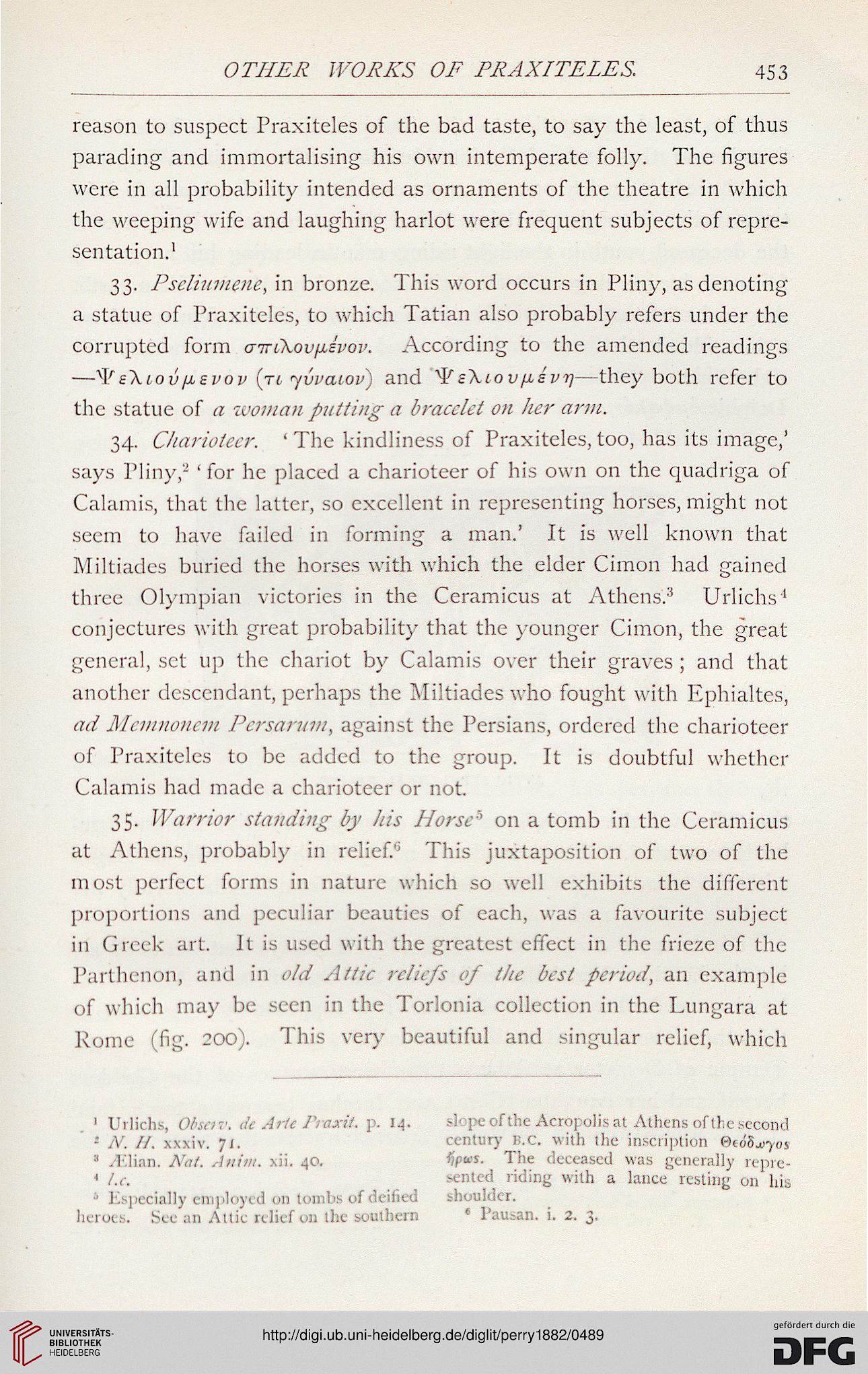OTHER WORKS OF PRAXITELES.
453
reason to suspect Praxiteles of the bad taste, to say the least, of thus
parading and immortalising his own intemperate folly. The figures
were in all probability intended as ornaments of the theatre in which
the weeping wife and laughing harlot were frequent subjects of repre-
sentation.1
33. Pscliumcnc, in bronze. This word occurs in Pliny, as denoting
a statue of Praxiteles, to which Tatian also probably refers under the
corrupted form airiXov^evov. According to the amended readings
—¥e\iovpevov (rt ywaiov) and sXiov/j,svy—they both refer to
the statue of a woman putting a bracelet on her arm.
34. Charioteer. ' The kindliness of Praxiteles, too, has its image,'
says Pliny,- ' for he placed a charioteer of his own on the quadriga of
Calamis, that the latter, so excellent in representing horses, might not
seem to have failed in forming a man.' It is well known that
Miltiadcs buried the horses with which the elder Cimon had gained
three Olympian victories in the Ceramicus at Athens.3 Urlichs'
conjectures with great probability that the younger Cimon, the great
general, set up the chariot by Calami's over their graves ; and that
another descendant, perhaps the Miltiades who fought with Ephialtes,
ad Maunoncm ]}crsarum, against the Persians, ordered the charioteer
of Praxiteles to be added to the group. It is doubtful whether
Calamis had made a charioteer or not.
35. Warrior standing by his Horse1' on a tomb in the Ceramicus
at Athens, probably in relief.'' This juxtaposition of two of the
most perfect forms in nature which so well exhibits the different
proportions and peculiar beauties of each, was a favourite subject
in Greek art. It is used with the greatest effect in the frieze of the
Parthenon, and in old Attie reliefs of the best period, an example
of which may be seen in the Torlonia collection in the Lungara at
Rome (fig. 200). This very beautiful and singular relief, which
1 Urlichs, Ohav. <!c Arte JYaxil. p. M-
1 N. //. xxxiv. 71.
3 .l'.linn. A'nt. Atiim. xii. 40.
« I.e.
1 Especially employed on tombs of deified
heroes. See an Attic relief on the southern
dope of the Acropolis at Athens of the second
century H.c. with the inscription BcdS^os
ijpws. The deceased was generally repre-
sented riding with a lance resting on his
shoulder.
■ Pau.-an. i. 2. 3.
453
reason to suspect Praxiteles of the bad taste, to say the least, of thus
parading and immortalising his own intemperate folly. The figures
were in all probability intended as ornaments of the theatre in which
the weeping wife and laughing harlot were frequent subjects of repre-
sentation.1
33. Pscliumcnc, in bronze. This word occurs in Pliny, as denoting
a statue of Praxiteles, to which Tatian also probably refers under the
corrupted form airiXov^evov. According to the amended readings
—¥e\iovpevov (rt ywaiov) and sXiov/j,svy—they both refer to
the statue of a woman putting a bracelet on her arm.
34. Charioteer. ' The kindliness of Praxiteles, too, has its image,'
says Pliny,- ' for he placed a charioteer of his own on the quadriga of
Calamis, that the latter, so excellent in representing horses, might not
seem to have failed in forming a man.' It is well known that
Miltiadcs buried the horses with which the elder Cimon had gained
three Olympian victories in the Ceramicus at Athens.3 Urlichs'
conjectures with great probability that the younger Cimon, the great
general, set up the chariot by Calami's over their graves ; and that
another descendant, perhaps the Miltiades who fought with Ephialtes,
ad Maunoncm ]}crsarum, against the Persians, ordered the charioteer
of Praxiteles to be added to the group. It is doubtful whether
Calamis had made a charioteer or not.
35. Warrior standing by his Horse1' on a tomb in the Ceramicus
at Athens, probably in relief.'' This juxtaposition of two of the
most perfect forms in nature which so well exhibits the different
proportions and peculiar beauties of each, was a favourite subject
in Greek art. It is used with the greatest effect in the frieze of the
Parthenon, and in old Attie reliefs of the best period, an example
of which may be seen in the Torlonia collection in the Lungara at
Rome (fig. 200). This very beautiful and singular relief, which
1 Urlichs, Ohav. <!c Arte JYaxil. p. M-
1 N. //. xxxiv. 71.
3 .l'.linn. A'nt. Atiim. xii. 40.
« I.e.
1 Especially employed on tombs of deified
heroes. See an Attic relief on the southern
dope of the Acropolis at Athens of the second
century H.c. with the inscription BcdS^os
ijpws. The deceased was generally repre-
sented riding with a lance resting on his
shoulder.
■ Pau.-an. i. 2. 3.




